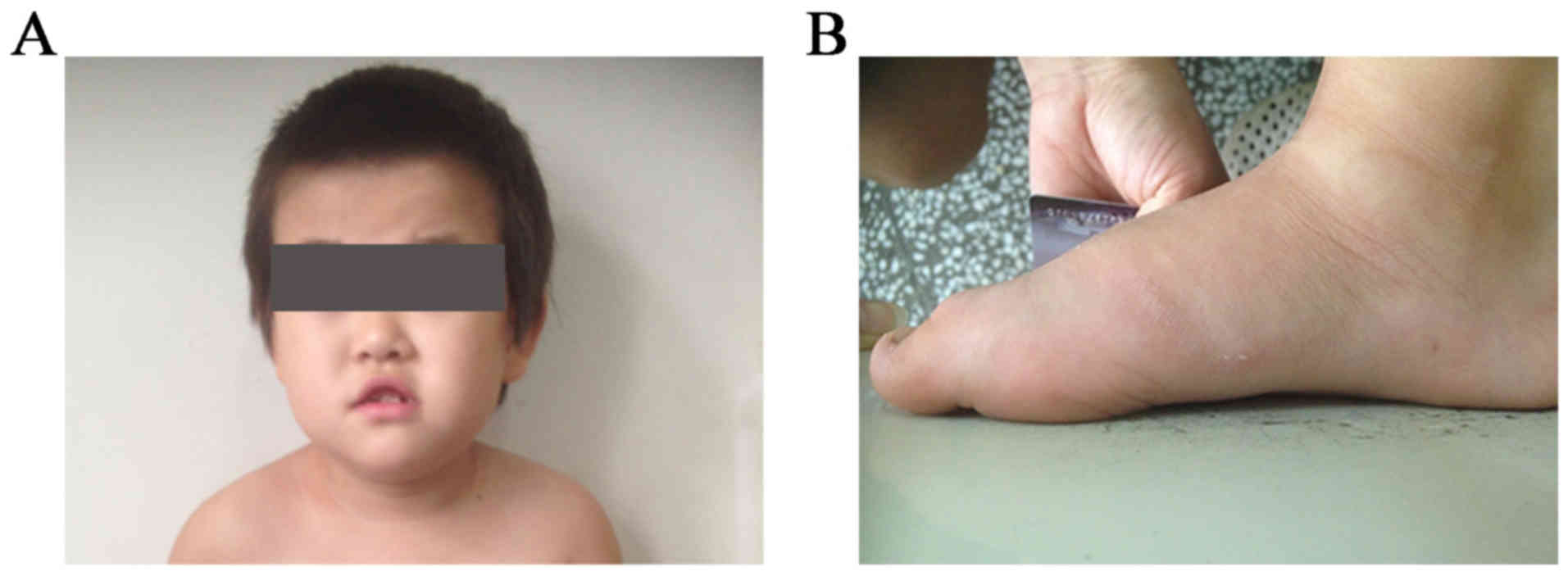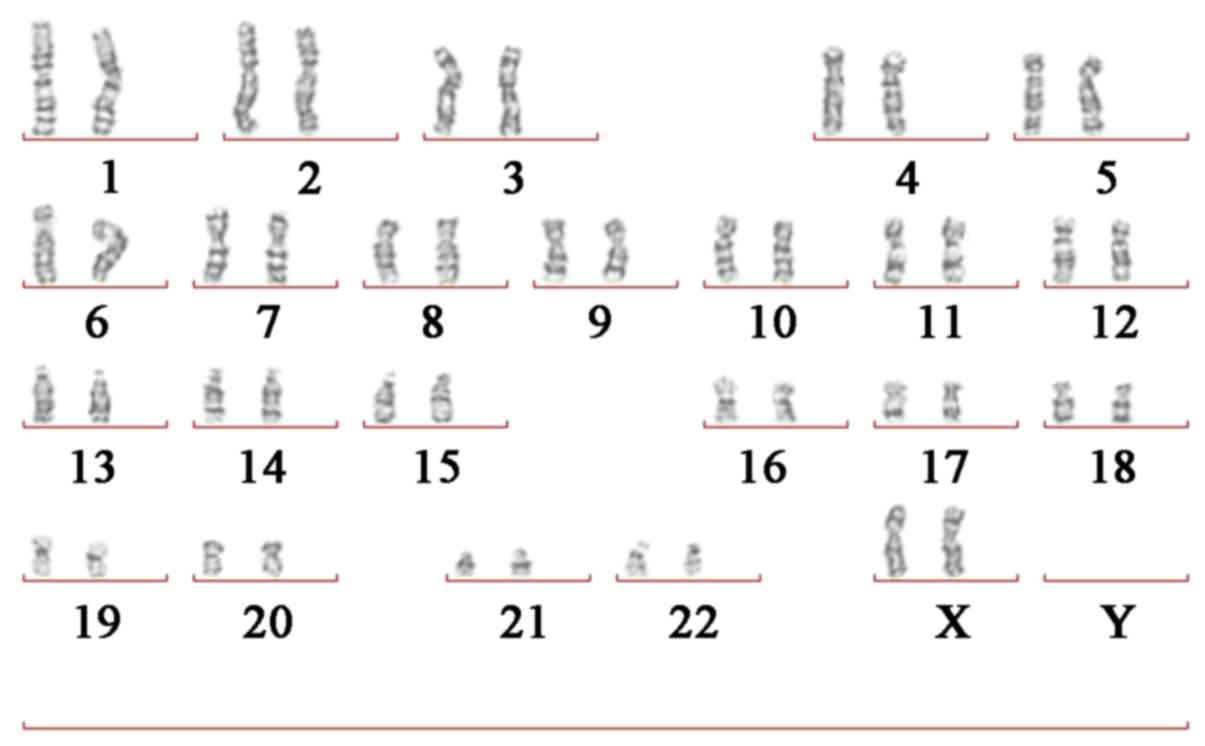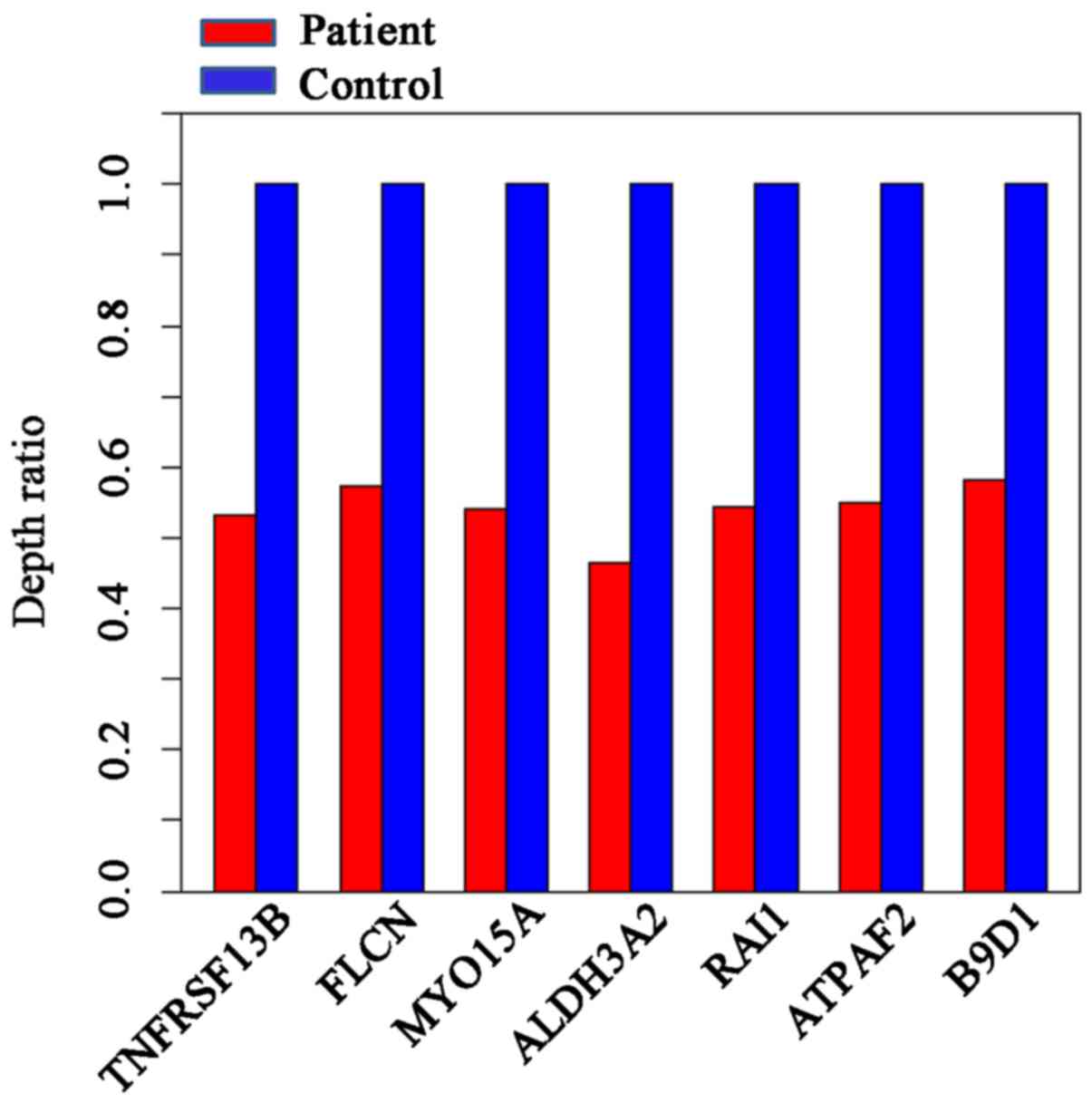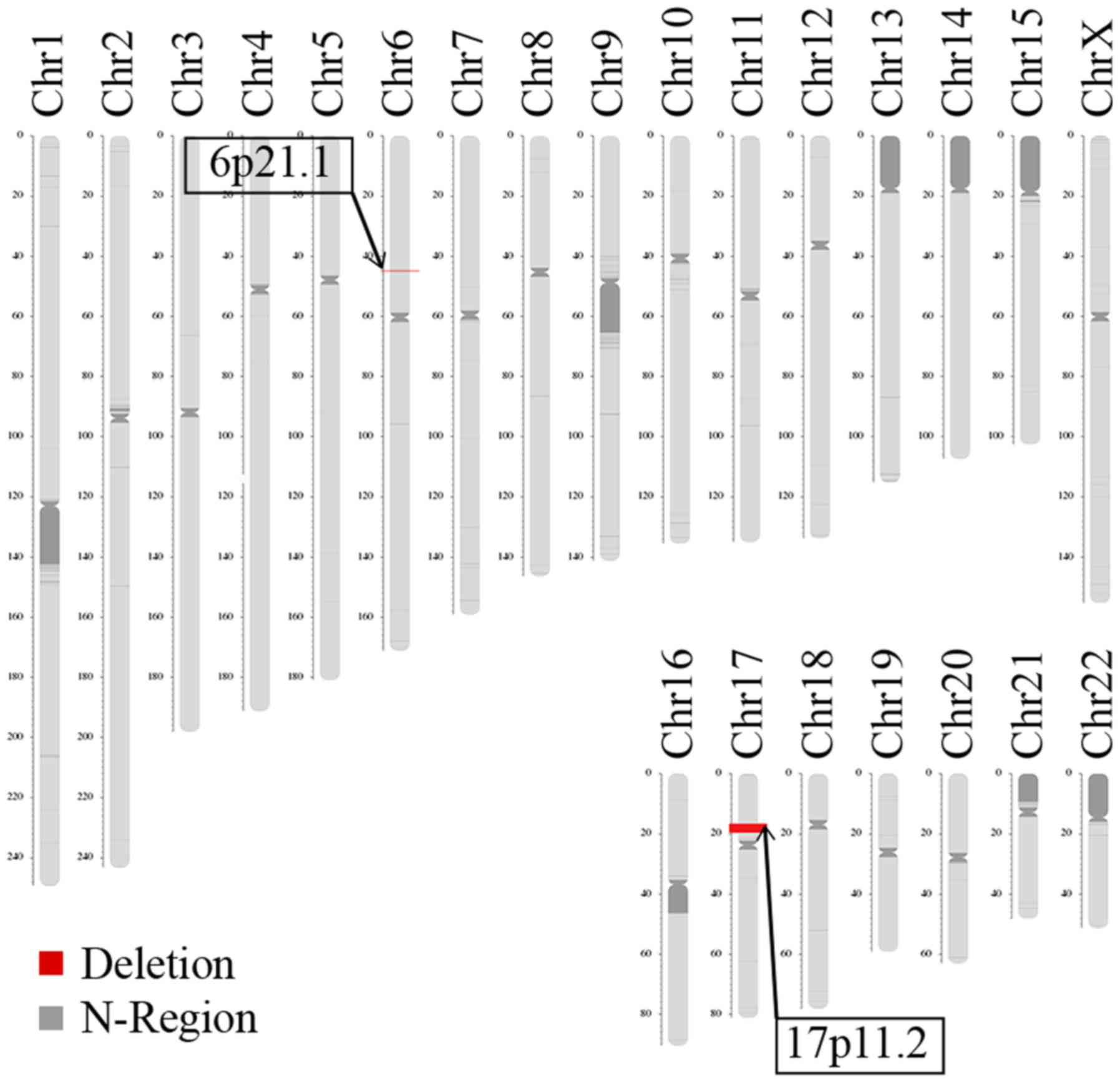Application of an improved targeted next generation sequencing method to diagnose non‑syndromic mental retardation in one step: A case report
- Authors:
- Published online on: May 17, 2018 https://doi.org/10.3892/mmr.2018.9031
- Pages: 981-986
Abstract
Introduction
Congenital mental retardation is a neurodevelopmental disease that affects 2–3% of the population worldwide (1,2). Genetic factors may explain >50% of congenital mental retardation cases (3). Chromosomal anomalies, including chromosomal deletion, duplication and trisomy contribute to 4–28% of cases and known monogenetic diseases explain 3–9% of cases (4). Various methods may be used to detect genetic abnormalities, including chromosomal microarray (CMA) and next generation sequencing (NGS) (5–10). However, the absence of any accompanying deformities in non-syndromic mental retardation makes it difficult to select the detection method. Using numerous methods increases cost and reduces efficiency. To the best of our knowledge, no method to detect genetic abnormalities in one step exists at present.
Typically, custom-made capture array-based targeted NGS is used to detect disease-causing mutations in monogenic disease (8). A custom-made capture array that is able to detect various types of mutations, including microdeletion, was previously designed (11). In the present study, this improved targeted NGS method was applied to diagnose a case of non-syndromic mental retardation of unknown cause. This may aid in the detection of genetic abnormalities in one step.
The microdeletion 17p11.2 was successfully detected by improved targeted NGS and no single gene mutations were identified. Subsequently, the same microdeletion was validated using low coverage whole-genome sequencing (LCS). Fertility guidance was additionally given to the parents of the patient.
In the present study, the patient was diagnosed with Smith-Magenis syndrome (SMS). SMS is a rare, congenital syndrome that affects ~1 in every 25,000 individuals. Features include mental retardation, behavioral abnormalities and distinctive facial features, difficulty sleeping, delayed speech and development, resulting from a 17p11.2 deletion encompassing the retinoic acid-induced protein 1 (RAI1) (12–14). It is estimated that 70% of patients with SMS have a common 3.7 Mb deletion; the remaining 30% have larger or smaller deletions. Approximately 90% of SMS patients have a 17p11.2 deletion; the remaining 30% have mutations in the RAI1 gene (15).
The present study applied an improved targeted NGS method to diagnose a patient with non-syndromic mental retardation of an unknown cause in an effective and a fast way, without using other methods. The result was validated by LCS. This improved method has the potential to be developed into a screening panel to effectively identify genetic abnormalities in non-syndromic mental retardation and other congenital anomalies.
Case report
Patient information
An 8-year-old Chinese Han female and her parents attended the Wuhan Medical & Health Center for Women and Children hospital due to developmental delay and signs of mental retardation that were present from infancy. The research was prospectively reviewed and approved by the ethics committee of BGI-Shenzhen (approval no. BGI-IRB 15083; Shenzen, China). Written informed consent for participation in the present study was obtained from the patient's parents.
The patient was the first child of unrelated parents who had no family history of inherited diseases. The patient was born by cesarean section with a birth weight of 3.35 kg and a body length of 50 cm. A distinct facial appearance was observed, with short palpebral fissures, a depressed nasal bridge, hypertelorism, and an upper lip with tented morphology and a V-like shape (Fig. 1A and B).
By age 2 years, the patient had sleep difficulties with nocturnal awakenings which gradually increased in frequency. The patient exhibited signs of mental retardation and decreased motor development compared with other children of the same age. The patient was talkative, although failed to convey information effectively.
Giemsa (G)-banded cytogenetic analysis
Routine G-banding chromosome analysis was performed as described (16); a 5 ml peripheral blood sample was collected from the patient and her parents. Chromosomes from cultured lymphocytic cells were treated with 0.25% trypsin (Sigma-Aldrich; Merck KGaA, Darmstadt, Germany) for 2 min at 37°C and stained with 6% Giemsa (Sigma-Aldrich; Merck KGaA) for 10 min at 37°C. The results revealed that the patient carried the normal karyotype (46 chromosomes; XX; Fig. 3). In addition, the parents of the patient carried the normal karyotype.
Improved targeted NGS
Improved targeted NGS was performed on peripheral blood samples of the patient. The designed capture array (NimbleGen; Roche Molecular Diagnostics, Pleasanton, CA, USA) focuses on known associated single gene-coding regions and flanking intronic boundaries 10 bp. The region that contained known microdeletions and microduplications was covered and a target spot at an interval of 0.1 Mb (length, 100 bp) was selected; for the remaining genome region, a target spot at an interval of 0.2 Mb (length, 100 bp) was selected (Fig. 2). Targeted NGS analysis with normalization was performed for the patient (17). The microdeletion and microduplication regions designed on this array were selected from the database of DECIPHER (18). The 45 known microdeletion and microduplication diseases can be identified at present listed in Table I.
Sequence capture, enrichment and elution was performed according to the standard protocol, as previously mentioned (11). Following enrichment, high-throughput sequencing was performed using the Illumina Hiseq2000 analyzer (Illumina, Inc., San Diego, CA, USA). Image analysis and base-calling were performed using the Illumina Pipeline version 1.3.4 (Illumina, Inc.).
The depth ratio (patient:control) was used to evaluate the microdeletions and microduplications; the control referred to healthy subjects unrelated to the patient (samples obtained from BGI). If the ratio is 1, this indicates that no deletion has been detected. A ratio of ~0.5 indicates the detection of a heterozygous deletion. A ratio of zero indicates a potential homozygous deletion.
The designed capture array identified a 17p11.2 deletion. No single gene mutations were identified. The depth ratio was obtained for seven genes located on 17p11.2; the average depth ratio of the patient was ~0.55, indicating a heterozygous deletion (Fig. 4). As chromosome 6 was not designed in the capture array, the specific deletion on chromosome 6 was not identified.
LCS
To validate the results obtained from the improved NGS method, LCS was additionally performed on the peripheral blood samples of the patient and parents using the Illumina Hiseq2000 (Illumina, Inc.) platform with the population-scale microdeletions and microduplications calling (PSCC) method, as described previously (19). PSCC is a stable and sensitive method for the detection of copy number variation (CNV). PSCC is able to identify deletions with a resolution in the 100 kb range. It has three modules which include a two-step correction procedure to remove the local GC content bias, a binary segmentation method to locate the candidate microdeletions and microduplications regions and a combined statistics test to estimate the signal reliability. Subsequently, the microdeletions and microduplications are determined.
LCS identified two deletions in the patient, located on 6p21.1 and 17p11.2 (Fig. 5). The deletion size on 6p21.1 was approximately 172.71 kb (chromosome 6, 44895251-45077965). The Database of Genomic Variants (dgv.tcag.ca/dgv/app/home) indicated that the identified deletion was not causative. The deletion size on 17p11.2 was approximately 3.66 Mb (chromosome 17, 16572714-20229256), which is typically observed in patients with SMS. The LCS results revealed the parents were normal, with no disease-causing microdeletions and microduplications or balanced translocation (data not shown).
Discussion
Congenital mental retardation is a neurodevelopmental disease with a variety of causes. Genetic factors have significant involvement in the etiology of congenital mental retardation (3). Numerous methods, including CMA and NGS, may be used to detect genetic abnormalities. However, it is difficult to initially select a method to be performed. Using a number of methods increases cost and reduces efficiency. At present, a method to detect genetic abnormalities in one step does not exist. Herein, an improved targeted NGS method was developed to diagnose chromosomal anomalies and single gene mutations in one step at low cost. In the present study, an unknown cause of non-syndromic mental retardation was successfully diagnosed with the improved targeted NGS method. SMS has similar phenotypic features to other syndromes, including 9q34 deletion syndrome, Prader-Willi syndrome, 22q11.2 syndrome, Sotos syndrome and Williams syndrome. Therefore, it may be easily misdiagnosed (14). In the present study, the improved targeted NGS method detected a deletion located in 17p11.2. Thus, the patient was accurately diagnosed with SMS.
The methods of the present study had certain limitations. Chromosomal microdeletions and microduplications were only detected in the targeted captured region, and the whole genome region was not covered. Therefore, breakpoints of chromosome aberration were unable to be detected. Additionally, there was the potential for false negative errors. A future study will improve the scheme to minimize the false negative rate, by increasing the targeted captured region and optimizing the information analysis algorithm.
Additionally, fertility guidance was given to the parents of the patient. The origin of the majority of deletions is de novo, and are more rarely attributed to an unbalanced segregation of a parental balanced translocation (20). In the present case, the chromosomes of the asymptomatic parents were normal; no disease-causing microdeletions, microduplications or balanced translocations were detected, indicating that the deletion 17p11.2 was de novo. The incidence of de novo deletions may primarily occur as random chance events during gamete formation or early embryo development. Therefore, the risk of having another affected child may be very low. However, the deletion may be caused by germline mosaicism, a well reported explanation of the possible origin of autosomal dominant and X-linked disorders (21–24). As for de novo deletions, limited information is available in the literature. Rothlisberger et al (20) reported that germline mosaicism is rare, although it may never be excluded as the origin of de novo structural aberrations. Sanchez et al (25) reported that a 15q11.2-q13 deletion in dizygotic twins with Angelman syndrome originated from somatic and germline mosaicism of the mother. The present study did not assess the possibility of germline mosaicism, as it is difficult to obtain gametes. However, prenatal testing should be proposed to this family during genetic counselling to minimize recurrence risks in subsequent gestation.
In summary, targeted NGS is typically used to detect variants of monogenic diseases. In the present study, it was investigated if the currently available targeted NGS was already suitable for the molecular diagnosis of microdeletion. Subsequently, the 17p11.2 deletion was identified by the designed capture array and no single gene mutation was identified. It was demonstrated that this method could successfully identify microdeletion and duplication. Therefore, this improved method has the potential to be developed into a screening panel for effective diagnosis of genetic abnormalities in non-syndromic mental retardation and other congenital anomalies.
Acknowledgements
Not applicable.
Funding
This work was supported by Shenzhen Technological Innovation Plan-Technology Development Project (grant no. CXZZ 20130517144604091).
Availability of data and materials
The datasets generated and/or analyzed during the current study are available from the corresponding author on reasonable request.
Author's contributions
WW, BM and YY designed the research and produced the first draft of the article. LM and XG performed the experimental studies. XW and DY contributed to drafting and revising the manuscript. HL, YS, XW and DY performed the data analysis.
Ethics approval and consent to participate
The research was prospectively reviewed and approved by the ethics committee of BGI-Shenzhen (approval no. BGI-IRB 15083; Shenzen, China). Written informed consent for participation in the present study was obtained from the patient's parents.
Consent for publication
Written informed consent for participation in the present study was obtained from the patient's parents.
Competing interests
The authors declare that they have no competing interests.
References
|
Daily DK, Ardinger HH and Holmes GE: Identification and evaluation of mental retardation. Am Fam Physician. 61(1059): 1067–1070. 2000. | |
|
Kaur A, Mahajan S and Singh JR: Cytogenetic Profile of Individuals with Mental Retardation. Int J Hum Genet. 3:13–16. 2003. View Article : Google Scholar | |
|
Chelly J, Khelfaoui M, Francis F, Chérif B and Bienvenu T: Genetics and pathophysiology of mental retardation. Eur J Hum Genet. 14:701–713. 2006. View Article : Google Scholar : PubMed/NCBI | |
|
Curry CJ, Stevenson RE, Aughton D, Byrne J, Carey JC, Cassidy S, Cunniff C, Graham JM Jr, Jones MC, Kaback MM, et al: Evaluation of mental retardation: Recommendations of a Consensus Conference: American College of Medical Genetics. Am J Med Genet. 72:468–477. 1997. View Article : Google Scholar : PubMed/NCBI | |
|
de Vries BB, Pfundt R, Leisink M, Koolen DA, Vissers LE, Janssen IM, Reijmersdal Sv, Nillesen WM, Huys EH, Leeuw Nd, et al: Diagnostic genome profiling in mental retardation. Am J Hum Genet. 77:606–616. 2005. View Article : Google Scholar : PubMed/NCBI | |
|
Pinto IP, Minasi LB, da Cruz AS, de Melo AV, da Cruz E, Cunha DM, Pereira RR, Ribeiro CL, da Silva CC, de Melo E Silva D and da Cruz AD: A non-syndromic intellectual disability associated with a de novo microdeletion at 7q and 18p, microduplication at Xp, and 18q partial trisomy detected using chromosomal microarray analysis approach. Mol Cytogenet. 7:442014. View Article : Google Scholar : PubMed/NCBI | |
|
Tucker T, Zahir FR, Griffith M, Delaney A, Chai D, Tsang E, Lemyre E, Dobrzeniecka S, Marra M, Eydoux P, et al: Single exon-resolution targeted chromosomal microarray analysis of known and candidate intellectual disability genes. Eur J Hum Genet. 22:792–800. 2014. View Article : Google Scholar : PubMed/NCBI | |
|
Martinez F, Caro-Llopis A, Roselló M, Oltra S, Mayo S, Monfort S and Orellana C: High diagnostic yield of syndromic intellectual disability by targeted next-generation sequencing. J Med Genet. 54:87–92. 2017. View Article : Google Scholar : PubMed/NCBI | |
|
Morgan A, Gandin I, Belcaro C, Palumbo P, Palumbo O, Biamino E, Dal Col V, Laurini E, Pricl S, Bosco P, et al: Target sequencing approach intended to discover new mutations in non-syndromic intellectual disability. Mutat Res. 781:32–36. 2015. View Article : Google Scholar : PubMed/NCBI | |
|
Ehmke N, Karge S, Buchmann J, Korinth D, Horn D, Reis O and Häßler F: A de novo nonsense mutation in ZBTB18 plus a de novo 15q13.3 microdeletion in a 6-year-old female. Am J Med Genet A. 173:1251–1256. 2017. View Article : Google Scholar : PubMed/NCBI | |
|
Liu Y, Wei X, Kong X, Guo X, Sun Y, Man J, Du L, Zhu H, Qu Z, Tian P, et al: Targeted next-generation sequencing for clinical diagnosis of 561 mendelian diseases. PLoS One. 10:e01336362015. View Article : Google Scholar : PubMed/NCBI | |
|
Smith AC, McGavran L, Robinson J, Waldstein G, Macfarlane J, Zonona J, Reiss J, Lahr M, Allen L and Magenis E: Interstitial deletion of (17)(p11.2p11.2) in nine patients. Am J Med Genet. 24:393–414. 1986. View Article : Google Scholar : PubMed/NCBI | |
|
Girirajan S, Elsas LJ II, Devriendt K and Elsea SH: RAI1 variations in Smith-Magenis syndrome patients without 17p11.2 deletions. J Med Genet. 42:820–828. 2005. View Article : Google Scholar : PubMed/NCBI | |
|
Elsea SH and Girirajan S: Smith-Magenis syndrome. Eur J Hum Genet. 16:412–421. 2008. View Article : Google Scholar : PubMed/NCBI | |
|
Slager RE, Newton TL, Vlangos CN, Finucane B and Elsea SH: Mutations in RAI1 associated with Smith-Magenis syndrome. Nat Genet. 33:466–468. 2003. View Article : Google Scholar : PubMed/NCBI | |
|
Seabright M: A rapid banding technique for human chromosomes. Lancet. 2:971–972. 1971. View Article : Google Scholar : PubMed/NCBI | |
|
Magi A, Tattini L, Pippucci T, Torricelli F and Benelli M: Read count approach for DNA copy number variants detection. Bioinformatics. 28:470–478. 2012. View Article : Google Scholar : PubMed/NCBI | |
|
Bragin E, Chatzimichali EA, Wright CF, Hurles ME, Firth HV, Bevan AP and Swaminathan GJ: DECIPHER: Database for the interpretation of phenotype-linked plausibly pathogenic sequence and copy-number variation. Nucleic Acids Res. 42:(Database issue). D993–D1000. 2014. View Article : Google Scholar : PubMed/NCBI | |
|
Li X, Chen S, Xie W, Vogel I, Choy KW, Chen F, Christensen R, Zhang C, Ge H, Jiang H, et al: PSCC: Sensitive and reliable population-scale copy number variation detection method based on low coverage sequencing. PLoS One. 9:e850962014. View Article : Google Scholar : PubMed/NCBI | |
|
Röthlisberger B and Kotzot D: Recurrence risk in de novo structural chromosomal rearrangements. Am J Med Genet A. 143A:1708–1714. 2007. View Article : Google Scholar : PubMed/NCBI | |
|
Wilton SD, Chandler DC, Kakulas BA and Laing NG: Identification of a point mutation and germinal mosaicism in a Duchenne muscular dystrophy family. Hum Mutat. 3:133–140. 1994. View Article : Google Scholar : PubMed/NCBI | |
|
Slavin TP, Lazebnik N, Clark DM, Vengoechea J, Cohen L, Kaur M, Konczal L, Crowe CA, Corteville JE, Nowaczyk MJ, et al: Germline mosaicism in Cornelia de Lange syndrome. Am J Med Genet A. 158A:1481–1485. 2012. View Article : Google Scholar : PubMed/NCBI | |
|
Bermúdez-López C, García-de Teresa B, González-del Angel A and Alcántara-Ortigoza MA: Germinal mosaicism in a sample of families with Duchenne/Becker muscular dystrophy with partial deletions in the DMD gene. Genet Test Mol Biomarkers. 18:93–97. 2014. View Article : Google Scholar : PubMed/NCBI | |
|
Miyagawa M, Nishio SY, Hattori M, Takumi Y and Usami S: Germinal mosaicism in a family with BO syndrome. Ann Otol Rhinol Laryngol. 124 Suppl 1:118S–122S. 2015. View Article : Google Scholar : PubMed/NCBI | |
|
Sánchez J, Fernández R, Madruga M, Bernabeu-Wittel J, Antiñolo G and Borrego S: Somatic and germ-line mosaicism of deletion 15q11.2-q13 in a mother of dyzigotic twins with Angelman syndrome. Am J Med Genet A. 164A:370–376. 2014. View Article : Google Scholar : PubMed/NCBI |














